Publications
Foundational articles
At the end of this page, you can find the full list of publications.
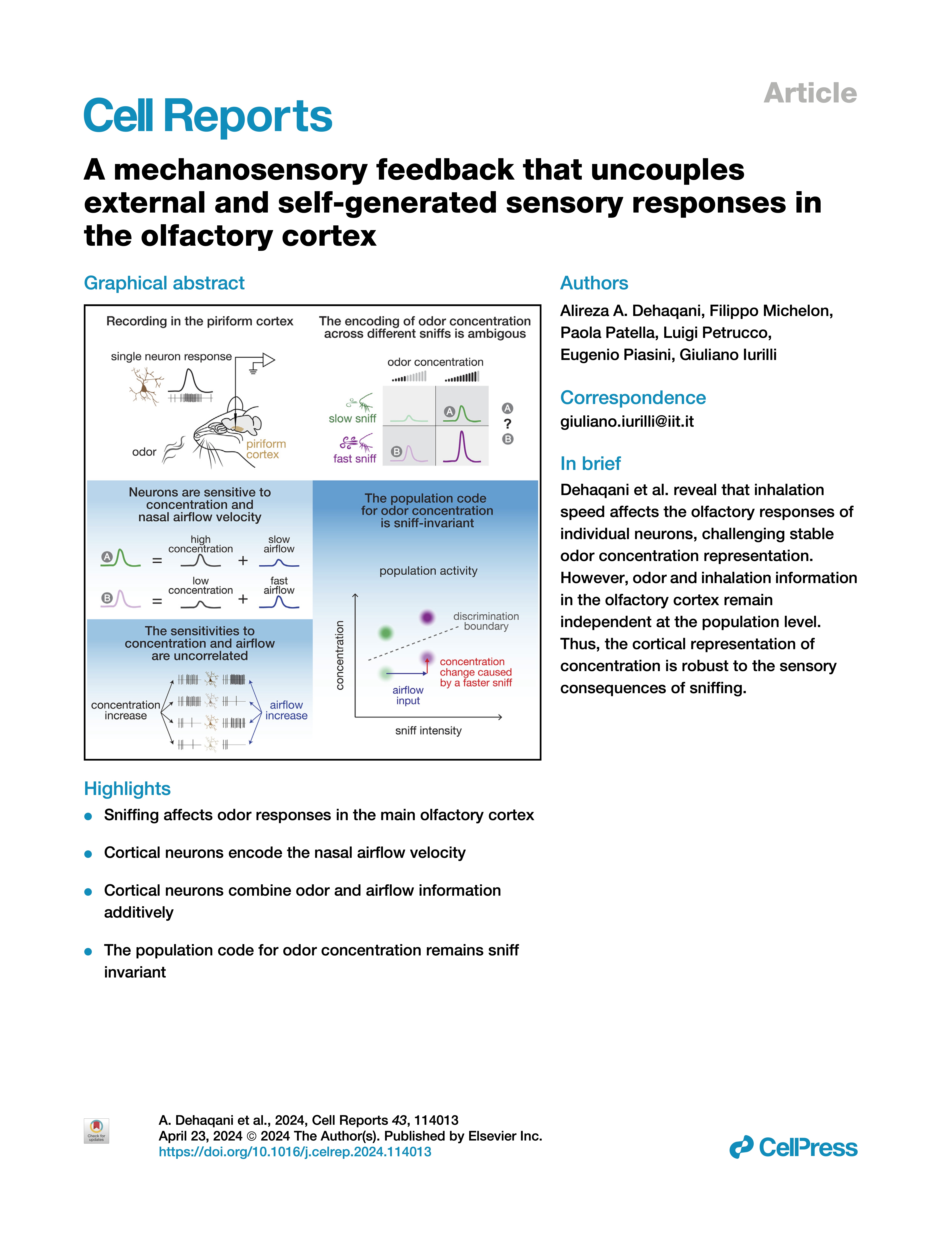
Sampling behaviors have sensory consequences that can hinder perceptual stability. In olfaction, sniffing affects early odor encoding, mimicking a sudden change in odor concentration. We examined how the inhalation speed affects the representation of odor concentration in the main olfactory cortex. Neurons combine the odor input with a global top-down signal preceding the sniff and a mechanosensory feedback generated by the air passage through the nose during inhalation. Still, the population representation of concentration is remarkably sniff invariant. This is because the mechanosensory and olfactory responses are uncorrelated within and across neurons. Thus, faster odor inhalation and an increase in concentration change the cortical activity pattern in distinct ways. This encoding strategy affords tolerance to potential concentration fluctuations caused by varying inhalation speeds. Since mechanosensory reafferences are widespread across sensory systems, the coding scheme described here may be a canonical strategy to mitigate the sensory ambiguities caused by movements.
Alireza A Dehaqani, Filippo Michelon, Paola Patella, Luigi Petrucco, Eugenio Piasini, Giuliano Iurilli

The cortex organizes sensory information to enable discrimination and generalization. As systematic representations of chemical odour space have not yet been described in the olfactory cortex, it remains unclear how odour relationships are encoded to place chemically distinct but similar odours, such as lemon and orange, into perceptual categories, such as citrus. Here, by combining chemoinformatics and multiphoton imaging in the mouse, we show that both the piriform cortex and its sensory inputs from the olfactory bulb represent chemical odour relationships through correlated patterns of activity. However, cortical odour codes differ from those in the bulb because cortex more strongly clusters together representations for related odours, selectively rewrites pairwise odour relationships, and better matches odour perception. The bulb-to-cortex transformation depends on the associative network originating within the piriform cortex, and can be reshaped by passive odour experience. Thus, cortex actively builds a structured representation of chemical odour space that highlights odour relationships; this representation is similar across individuals but remains plastic, suggesting a means through which the olfactory system can assign related odour cues to common and yet personalized percepts.
Stan L. Pashkovski, Giuliano Iurilli, David Brann, Daniel Chicharro, Kristen Drummey, Kevin M. Franks, Stefano Panzeri, Sandeep Robert Datta
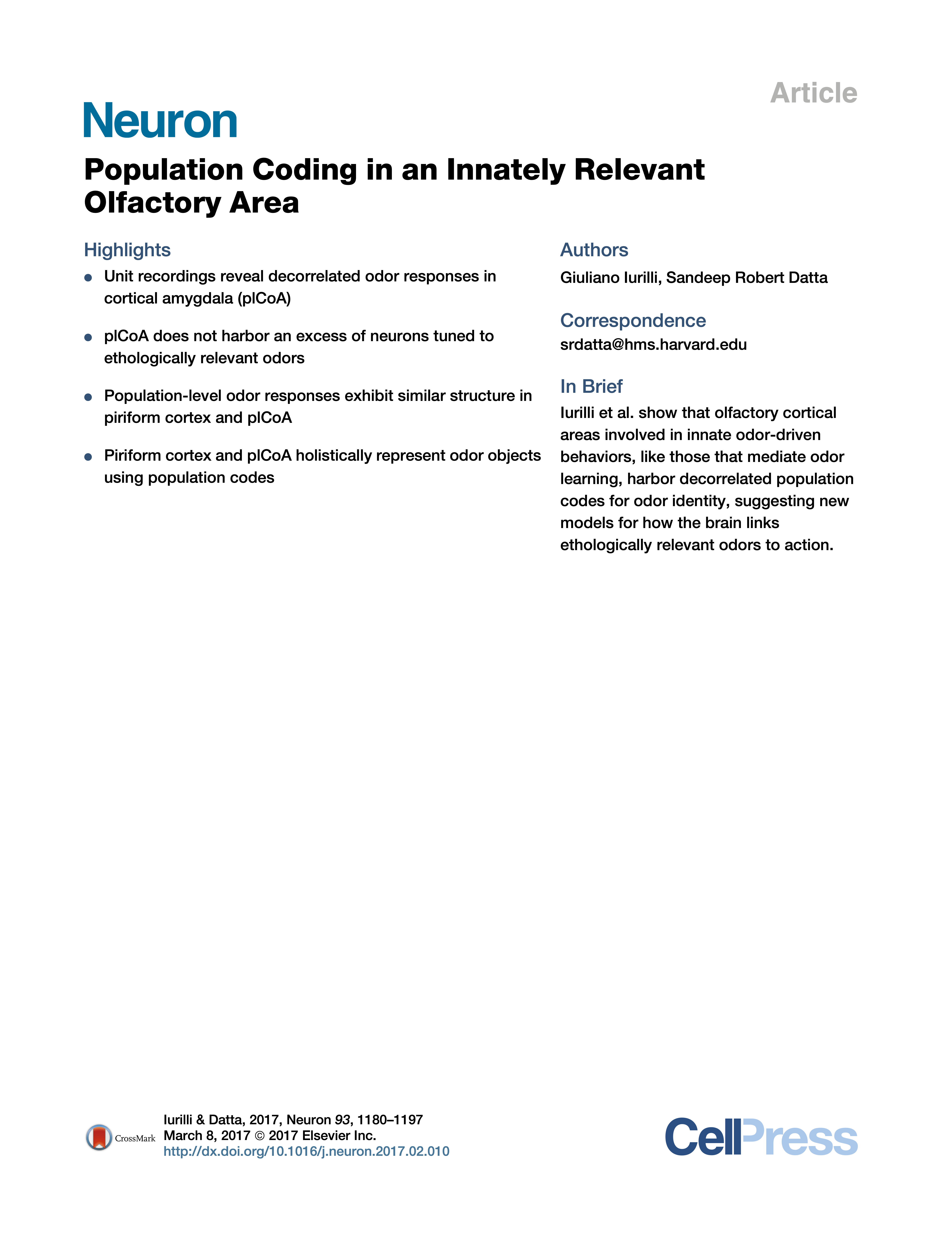
Different olfactory cortical regions are thought to harbor distinct sensory representations, enabling each area to play a unique role in odor perception and behavior. In the piriform cortex (PCx), spatially dispersed sensory inputs evoke activity in distributed ensembles of neurons that act as substrates for odor learning. In contrast, the posterolateral cortical amygdala (plCoA) receives hardwired inputs that may link specific odor cues to innate olfactory behaviors. Here we show that despite stark differences in the patterning of plCoA and PCx inputs, odor-evoked neural ensembles in both areas are equally capable of discriminating odors, and exhibit similar odor tuning, reliability, and correlation structure. These results demonstrate that brain regions mediating odor-driven innate behaviors can, like brain areas involved in odor learning, represent odor objects using distributive population codes; these findings suggest both alternative mechanisms for the generation of innate odor-driven behaviors and additional roles for the plCoA in odor perception.
Giuliano Iurilli, Sandeep Robert Datta
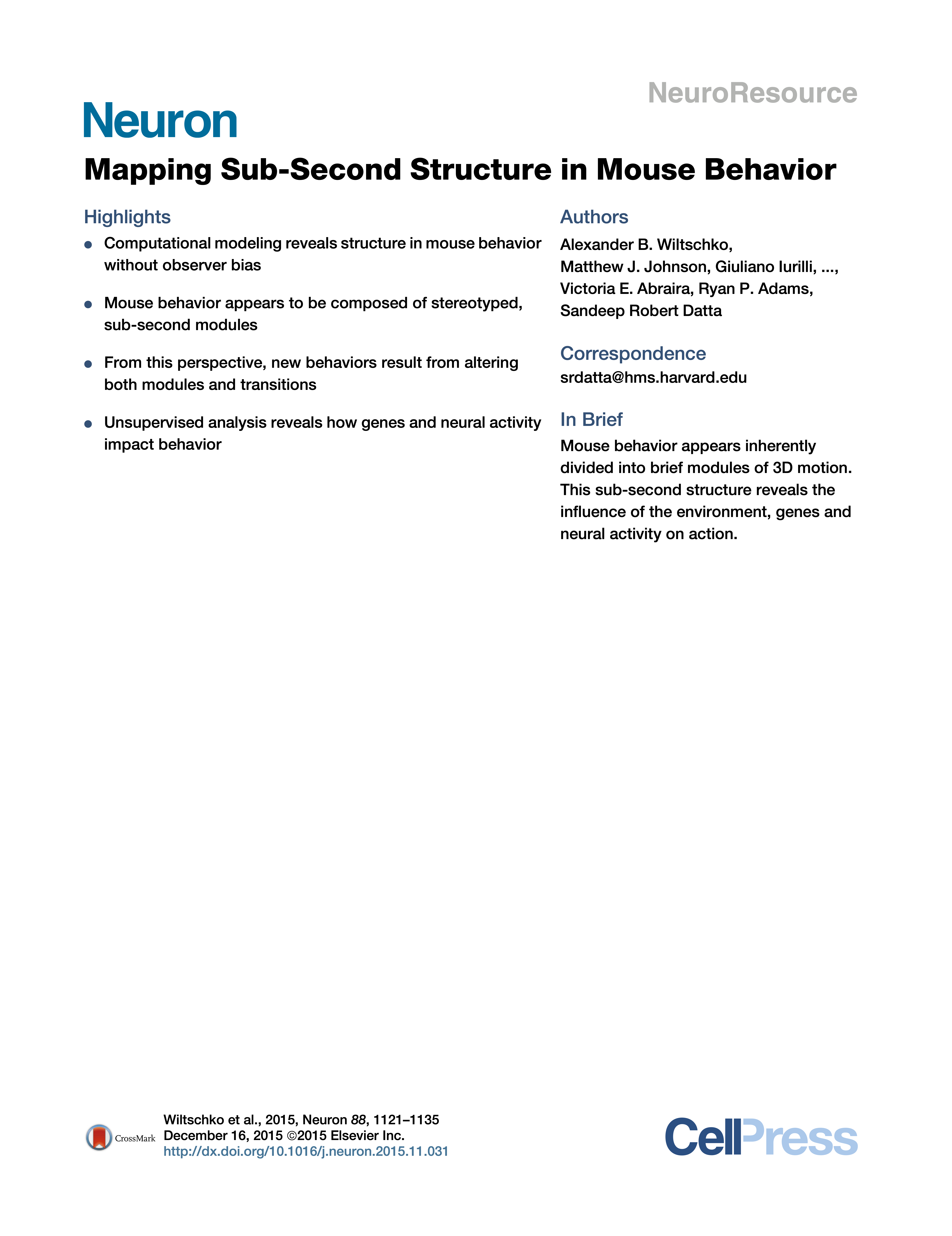
Complex animal behaviors are likely built from simpler modules, but their systematic identification in mammals remains a significant challenge. Here we use depth imaging to show that 3D mouse pose dynamics are structured at the sub-second timescale. Computational modeling of these fast dynamics effectively describes mouse behavior as a series of reused and stereotyped modules with defined transition probabilities. We demonstrate this combined 3D imaging and machine learning method can be used to unmask potential strategies employed by the brain to adapt to the environment, to capture both predicted and previously hidden phenotypes caused by genetic or neural manipulations, and to systematically expose the global structure of behavior within an experiment. This work reveals that mouse body language is built from identifiable components and is organized in a predictable fashion; deciphering this language establishes an objective framework for characterizing the influence of environmental cues, genes and neural activity on behavior.
Alexander B Wiltschko, Matthew J Johnson, Giuliano Iurilli, Ralph E Peterson, Jesse M Katon, Stan L Pashkovski, Victoria E Abraira, Ryan P Adams, Sandeep Robert Datta
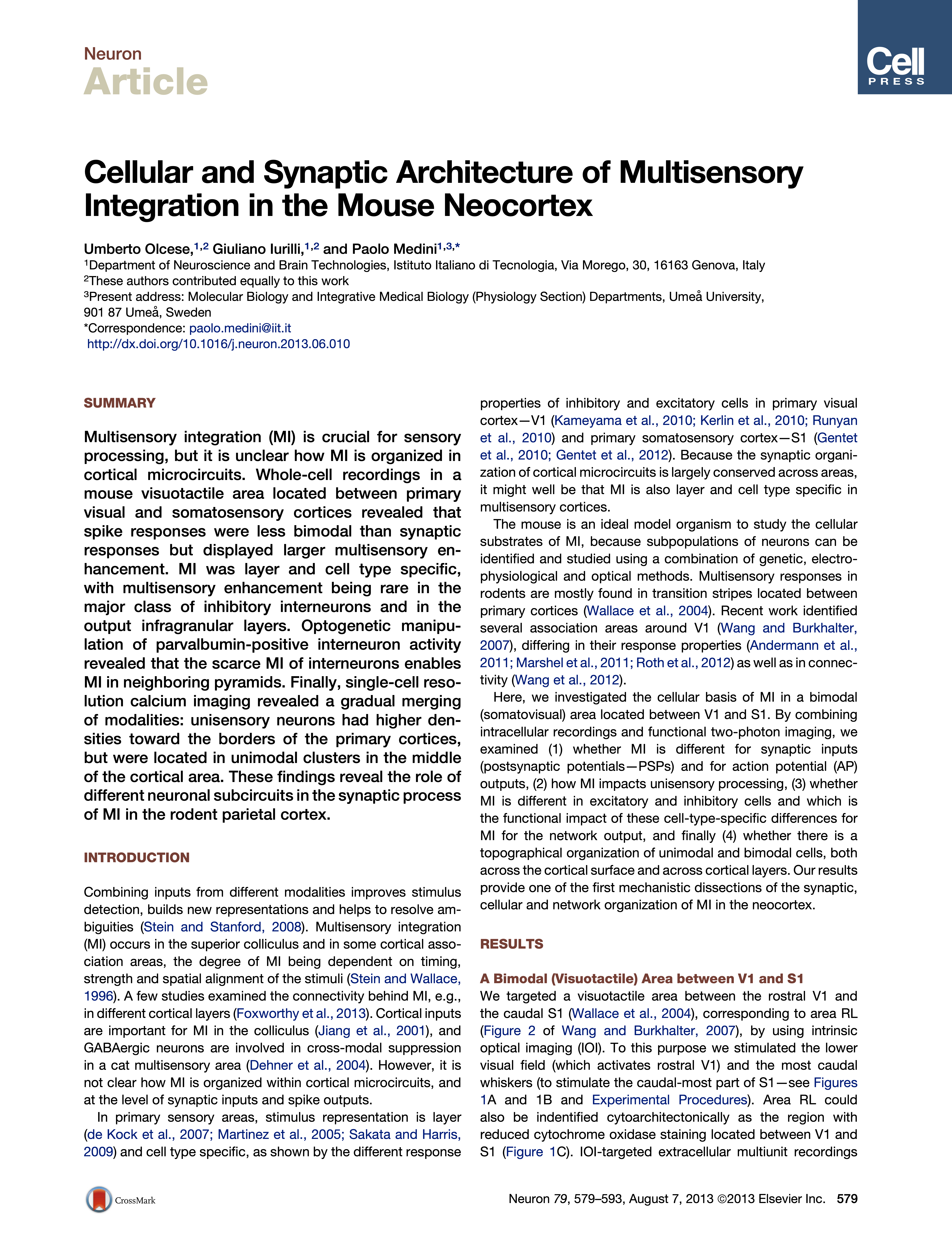
Multisensory integration (MI) is crucial for sensory processing, but it is unclear how MI is organized in cortical microcircuits. Whole-cell recordings in a mouse visuotactile area located between primary visual and somatosensory cortices revealed that spike responses were less bimodal than synaptic responses but displayed larger multisensory enhancement. MI was layer and cell type specific, with multisensory enhancement being rare in the major class of inhibitory interneurons and in the output infragranular layers. Optogenetic manipulation of parvalbumin-positive interneuron activity revealed that the scarce MI of interneurons enables MI in neighboring pyramids. Finally, single-cell resolution calcium imaging revealed a gradual merging of modalities. Unisensory neurons had higher densities toward the borders of the primary cortices, but were located in unimodal clusters in the middle of the cortical area. These findings reveal the role of different neuronal subcircuits in the synaptic process of MI in the rodent parietal cortex.
Umberto Olcese *, Giuliano Iurilli *, Paolo Medini
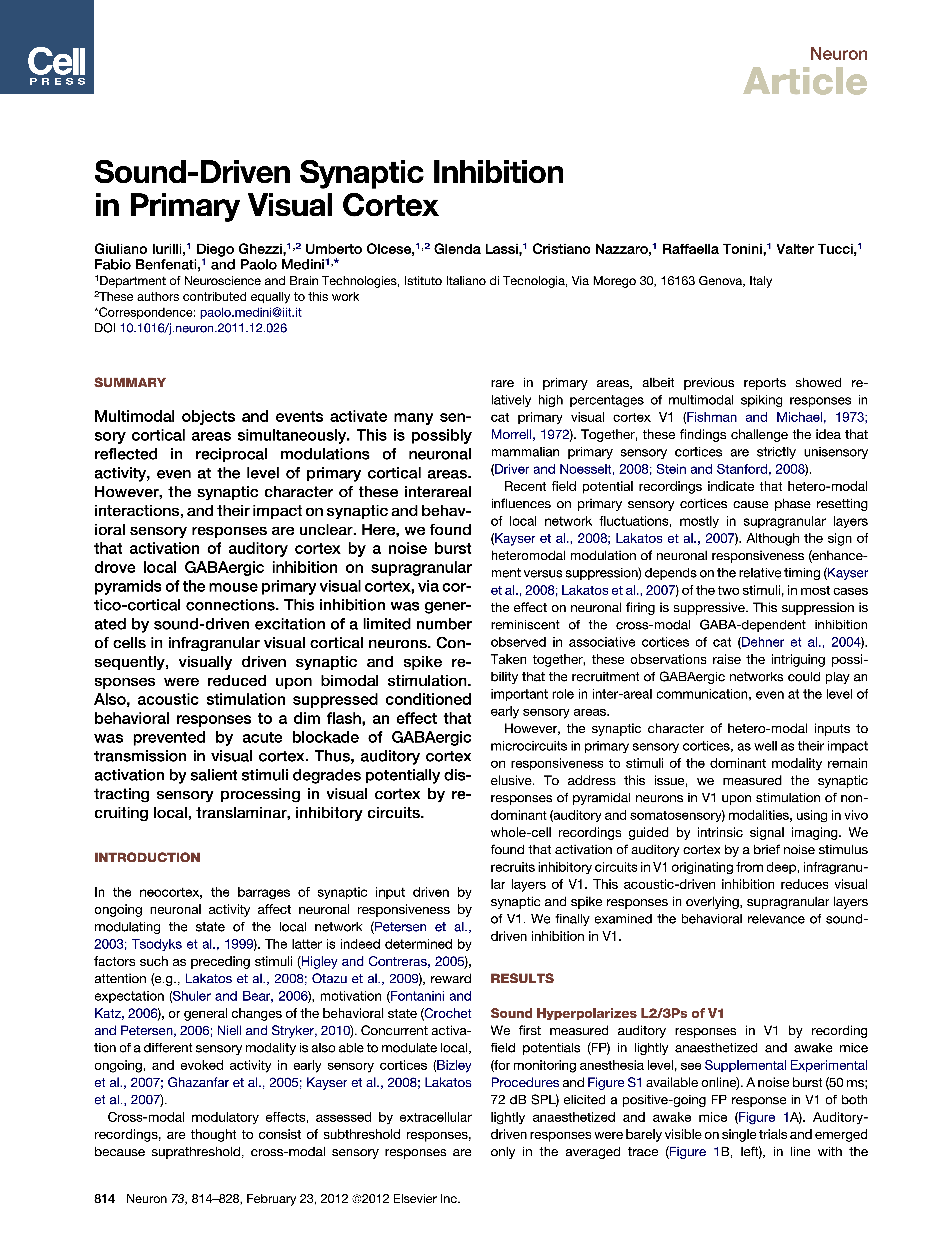
Salient events activate many sensory cortical areas simultaneously.However, the synaptic character of these global effects, and their impact on synaptic and behavioral sensory responses are unclear. Here, we found that a noise burst drove local GABAergic inhibition on supragranular pyramids of the mouse primary visual cortex, via cortico-cortical connections. Similar inhibition were observed alo in the somatosensory cortex.This inhibition was generated by the excitation of a limited number of cells in infragranular cortical neurons. Consequently, visually driven synaptic and spike responses were reduced upon bimodal stimulation. Also, noise bursts suppressed conditioned behavioral responses to a dim flash, an effect that was prevented by acute blockade of GABAergic transmission in visual cortex. Thus, salient stimuli degrades potentially distracting sensory processing in visual cortex by recruiting local, translaminar, inhibitory circuits.
Giuliano Iurilli, Diego Ghezzi, Umberto Olcese, Glenda Lassi, Cristiano Nazzaro, Raffaella Tonini, Valter Tucci, Fabio Benfenati, Paolo Medini
Full list of publications
A mechanosensory feedback that uncouples external and self-generated sensory responses in the olfactory cortex
Alireza A Dehaqani, Filippo Michelon, Paola Patella, Luigi Petrucco, Eugenio Piasini, Giuliano Iurilli
Cell Reports 43, 4 (2024)
Increased fMRI connectivity upon chemogenetic inhibition of the mouse prefrontal cortex
Federico Rocchi, Carola Canella, Shahryar Noei, Daniel Gutierrez-Barragan, Ludovico Coletta, Alberto Galbusera, Alexia Stuefer, Stefano Vassanelli, Massimo Pasqualetti, Giuliano Iurilli, Stefano Panzeri, Alessandro Gozzi
Nature Communications 13:1056 (2022)
Abnormal whisker-dependent behaviors and altered cortico-hippocampal connectivity in Shank3b−/− mice
Luigi Balasco , Marco Pagani, Luca Pangrazzi, Gabriele Chelini, Alessandra Georgette Ciancone Chama, Evgenia Shlosman, Lorenzo Mattioni, Alberto Galbusera, Giuliano Iurilli, Giovanni Provenzano, Alessandro Gozzi, Yuri Bozzi
Cerebral Cortex 32, 14 (2022)
Structure and flexibility in cortical representations of odour space
Stan L. Pashkovski, Giuliano Iurilli, David Brann, Daniel Chicharro, Kristen Drummey, Kevin M. Franks, Stefano Panzeri, Sandeep Robert Datta
Nature 583, 253-258 (2020)
Filopodia Conduct Target Selection in Cortical Neurons Using Differences in Signal Kinetics of a Single Kinase
Yu-Ting Mao, Julia X. Zhu, Kenji Hanamura, Giuliano Iurilli, Sandeep Robert Datta, Matthew B. Dalva
Neuron 98, 4 (2018)
Population Coding in an Innately Relevant Olfactory Area
Giuliano Iurilli, Sandeep Robert Datta
Neuron 93, 5 (2017)
Mapping Sub-Second Structure in Mouse Behavior
Alexander B Wiltschko, Matthew J Johnson, Giuliano Iurilli, Ralph E Peterson, Jesse M Katon, Stan L Pashkovski, Victoria E Abraira, Ryan P Adams, Sandeep Robert Datta
Neuron 88, 6 (2015)
Synaptic recruitment of gephyrin regulates surface GABAA receptor dynamics for the expression of inhibitory LTP
Enrica Maria Petrini, Tiziana Ravasenga, Torben J Hausrat, Giuliano Iurilli, Umberto Olcese, Victor Racine, Jean-Baptiste Sibarita, Tija C Jacob, Stephen J Moss, Fabio Benfenati, Paolo Medini, Matthias Kneussel, Andrea Barberis
Nature Communications 5, 3921 (2014)
Preserved excitatory-inhibitory balance of cortical synaptic inputs following deprived eye stimulation after a saturating period of monocular deprivation in rats
Giuliano Iurilli, Umberto Olcese, Paolo Medini
PloS One 12, 8 (2013)
Cellular and synaptic architecture of multisensory integration in the mouse neocortex
Umberto Olcese *, Giuliano Iurilli *, Paolo Medini
Neuron 7, 79 (2013)
Sound-driven synaptic inhibition in primary visual cortex
Giuliano Iurilli, Diego Ghezzi, Umberto Olcese, Glenda Lassi, Cristiano Nazzaro, Raffaella Tonini, Valter Tucci, Fabio Benfenati, Paolo Medini
Neuron 23, 73 (2012)
Loss of visually driven synaptic responses in layer 4 regular-spiking neurons of rat visual cortex in absence of competing inputs
Giuliano Iurilli, Fabio Benfenati, Paolo Medini
Cerebral Cortex 22, 9 (2012)
Flexible, all-polymer microelectrode arrays for the capture of cardiac and neuronal signals
Axel Blau, Angelika Murr, Sandra Wolff, Evelyne Sernagor, Paolo Medini, Giuliano Iurilli, Christiane Ziegler, Fabio Benfenati
Biomaterials 32, 7 (2011)